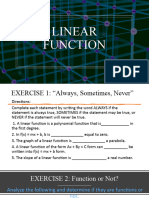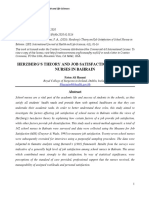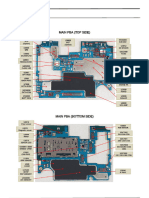Vertical Line Test
Vertical Line Test
Uploaded by
내가누구야Copyright:
Available Formats
Vertical Line Test
Vertical Line Test
Uploaded by
내가누구야Original Title
Copyright
Available Formats
Share this document
Did you find this document useful?
Is this content inappropriate?
Copyright:
Available Formats
Vertical Line Test
Vertical Line Test
Uploaded by
내가누구야Copyright:
Available Formats
RELATION it is a set of ordered pairs
the domain of a relation is the set of first coordinates
the range of a relation is the set of second coordinates.
In an ordered pair, the x-coordinate tells you the number of
units left or right and y-coordinate tells you the number of
units up or down.
Function Each letter (x-coordinate) corresponds to exactly one number (y-
coordinate). This is a special kind of relation
It is a relation in which each element of the domain corresponds to
exactly one element of the range.
WAYS TO REPRESENT A FUNCTION 1. Mapping Diagram
2. Table of values
3. Graph
CHARACTERISTICS OF A FUNCTION 1. Each element in domain X must be matched with exactly one
element in the range Y.
2. Some elements in Y may not be matched with any element in X.
3. Two or more elements in X may be matched with the same
element in Y
VERTICAL LINE TEST 1. Each element in domain X must be matched with exactly one
element in the range Y.
2. Some elements in Y may not be matched with any element in
X.
3. Two or more elements in X may be matched with the same
element in Y
VERTICAL LINE TEST it determines whether a graph of relation is a function or not
this can be done by passing or drawing a vertical line through
the graph of its ordered pair
A relation is a function if the vertical line intersects or passes
through its graph in only one point
Function or not a function
PIECEWISE FUNCTION It is also known as a compound function. It is a function defined
by multiple subfunctions, where each subfunction applies to a
certain interval of the main function's domain
It is defined by two equations. One gives the value of f(x) when
x is less than or equal to 1, and the other equation gives the value
of f(x) when x is greater than 1
HORIZONTAL LINE TEST A function is one-to-one if the horizontal line intersects or
passes through its graph in only one point
One to One function or not
GRAPHING A FUNCTION Use x=-3 to x=3 to construct the table of values and substitute
each value of x to the given function f(x) to get the
corresponding value of y, then graph.
GRAPHIC A FUNCTION EXAMPLES:
2. Evaluation of function
LAW OF SUBSTITUTION If a+x=b and x=c, then a+c=b.
Law of substitution examples:
Even Function A function if only f(-x)=f(x) for all x in the domain of f
The right-hand side of the equation of the even function does not
change even if x is replaced with -x
Odd Function A function if and only if f(-x)=-f(x), for all x in the domain of f
ODD, EVEN, NEITHER EXAMPLES:
3. Operations on Function
Polynomial A polynomial is defined as an expression which is composed of
terms, variables, constants, and exponents. 4x2+3y-10
Monomial It is an expression that has one term b. Binomial- It is an expression
that has two terms c. Trinomial-It is an expression that has three
terms
Addition of Polynomials To add polynomials, write the sum and simplify by combining like
terms.
Subtraction of Polynomials To subtract an expression from another expression, add its
negative.
LAWS OF EXPONENTS Product Rule for Exponents
Power Rule for Exponents
Power of a Product Rule
Product Rule for Exponents xmoxn=xm+n
To multiply powers having the same base, keep the base and add
the exponents.
Power Rule for Exponents (xm)n=xmn
To find the power of a power of a base, keep the base and multiply
the exponents.
Power of a Product Rule (xy)n=x"yn
To find the power of a product, find the power of each factor and
then multiply the resulting powers.
4. COMPOSITION OF FUNCTIONS
The composition of the function f with g is denoted by fog and is (fog)(x)=f(g(x))
defined by the equation
The domain of the composition function fog is the set of all x such 1. x is in the domain of g; and 2. g(x) is in the domain of f.
that
You might also like
- Grade 12 Investigation 2023 - INVERSE FUNCTIONSDocument9 pagesGrade 12 Investigation 2023 - INVERSE FUNCTIONSNqobile50% (2)
- Positionality StatementDocument4 pagesPositionality Statementapi-610612140No ratings yet
- An Analysis of Investor's Behaviour On Various Investments Avenues in IndiaDocument7 pagesAn Analysis of Investor's Behaviour On Various Investments Avenues in IndiaRakeshNo ratings yet
- Active Standard ASTM A694 / A694M: Steel StandardsDocument3 pagesActive Standard ASTM A694 / A694M: Steel Standardshemant_solanki78940% (1)
- General MathDocument5 pagesGeneral MathKaireen OzNo ratings yet
- Gen. Math Module 4Document4 pagesGen. Math Module 4Robert ClavoNo ratings yet
- Rational FunctionsDocument28 pagesRational FunctionsPrince Christian GarciaNo ratings yet
- Relations and FunctionsDocument2 pagesRelations and FunctionsCheMNo ratings yet
- Functions and RelationsDocument4 pagesFunctions and RelationsEdwin SulitNo ratings yet
- Week 1 - Revisiting and Evaluating FunctionsDocument12 pagesWeek 1 - Revisiting and Evaluating FunctionsShifra Jane PiqueroNo ratings yet
- General Mathematics: Functions and Their GraphsDocument5 pagesGeneral Mathematics: Functions and Their GraphsPrincess VillanuevaNo ratings yet
- Lecture 2 FunctionsDocument31 pagesLecture 2 FunctionsmkhtrzubairNo ratings yet
- Definition of Terms: Week 1: Lesson 1: General Mathematics 11Document1 pageDefinition of Terms: Week 1: Lesson 1: General Mathematics 11Darcy Ginn AlamaniNo ratings yet
- Lesson 1: Functions: SolutionDocument4 pagesLesson 1: Functions: Solutionrose ynqueNo ratings yet
- General Math (1st Sem)Document12 pagesGeneral Math (1st Sem)Yhannz DinglasanNo ratings yet
- Chapter 1 Vocabulary ListDocument2 pagesChapter 1 Vocabulary ListLeetz123456No ratings yet
- Cha-1 Calculus Functions Lecture NoteDocument38 pagesCha-1 Calculus Functions Lecture NotedemilieNo ratings yet
- FunctionsDocument51 pagesFunctionsJames Hiro GeraldinoNo ratings yet
- Chapter 5.1Document11 pagesChapter 5.1afiq azharyNo ratings yet
- One To One FunctionDocument9 pagesOne To One FunctionRymart ZaragozaNo ratings yet
- Math 8 Quarter II ReviewersDocument15 pagesMath 8 Quarter II ReviewersIlagan, Aadi Uniz T.No ratings yet
- General MathematicsDocument27 pagesGeneral MathematicsLei Ann MendozaNo ratings yet
- 1 FunctionsDocument31 pages1 Functions6wng8dmrqwNo ratings yet
- 2018 G12 Math E PDFDocument215 pages2018 G12 Math E PDFhamza50% (2)
- 0 BooksDocument23 pages0 BooksAjay KumarNo ratings yet
- College and Advanced Algebra Handout # 1 - Chapter 1. FunctionsDocument8 pagesCollege and Advanced Algebra Handout # 1 - Chapter 1. FunctionsMary Jane BugarinNo ratings yet
- Lesson 1.3 Operations On FunctionsDocument11 pagesLesson 1.3 Operations On FunctionsJomel RositaNo ratings yet
- Additional ReviewerDocument19 pagesAdditional ReviewerAcel PerezNo ratings yet
- 02 Shuborno FunctionalEquations1 FinalDocument9 pages02 Shuborno FunctionalEquations1 FinalMani Shankar RajanNo ratings yet
- Lecture 1 - Relations and FunctionsDocument31 pagesLecture 1 - Relations and FunctionsAnthony Balatar100% (1)
- First Elements Ordered Pairs Set Second Elements: RelationDocument9 pagesFirst Elements Ordered Pairs Set Second Elements: Relationjoyce.bacnaon301426No ratings yet
- GM Reviewer Q1Document2 pagesGM Reviewer Q1Tricia BaltazarNo ratings yet
- FunctionsDocument12 pagesFunctionsMuhammad Aamir FeroziNo ratings yet
- Genmath. 1st Quarter ReviewerDocument16 pagesGenmath. 1st Quarter ReviewerAlexa NicoleNo ratings yet
- Funtions and Its TypesDocument7 pagesFuntions and Its Typesfaizan.ahmed03368448721No ratings yet
- FunctionsDocument12 pagesFunctionsmariamsaeed2806No ratings yet
- FunctionsDocument12 pagesFunctionsmariamsaeed2806No ratings yet
- Module 3. One-To-One and Inverse FunctionsDocument12 pagesModule 3. One-To-One and Inverse FunctionsMori OugaiNo ratings yet
- General Mathematics: Quarter 1 - Module 1Document11 pagesGeneral Mathematics: Quarter 1 - Module 1jared alonzoNo ratings yet
- Functions and Limits: Animation 1.1: Function Machine Source and Credit: Elearn - PunjabDocument23 pagesFunctions and Limits: Animation 1.1: Function Machine Source and Credit: Elearn - PunjabAhmadAwanNo ratings yet
- Relation Is A Set of Ordered PairsDocument17 pagesRelation Is A Set of Ordered PairsJeoffrey MagtotoNo ratings yet
- MMW (Lect #2) TransDocument3 pagesMMW (Lect #2) TransChristine Mhae DavidNo ratings yet
- English For Mathematics-ThuyDocument34 pagesEnglish For Mathematics-ThuyChiến TrầnNo ratings yet
- Part 1 Functions Equations and Their GraphsDocument30 pagesPart 1 Functions Equations and Their GraphsJianne AlegreNo ratings yet
- Portfolio GenMathDocument24 pagesPortfolio GenMathGabrielle Laurie L. Fiesta100% (2)
- Linear FunctionDocument15 pagesLinear Functionkishnikamarielozano13No ratings yet
- Gen MathDocument1 pageGen MathDavis PasuquinNo ratings yet
- Coordinate Geometry, Relations, Functions, Graphs and VariationsDocument30 pagesCoordinate Geometry, Relations, Functions, Graphs and VariationsAnthony BensonNo ratings yet
- General MathematicsDocument13 pagesGeneral MathematicsMarc Alquin CantoNo ratings yet
- G11 - General Mathematics - 1st Sem - Midterm NotesDocument5 pagesG11 - General Mathematics - 1st Sem - Midterm NotesaglubatjohngrayNo ratings yet
- Chap 12Document38 pagesChap 12Dawood MNo ratings yet
- General Mathematics 11 Module 1 2021Document15 pagesGeneral Mathematics 11 Module 1 2021Mica Ella OlivarNo ratings yet
- + BX + C, Is An Example of A Polynomial FunctionDocument1 page+ BX + C, Is An Example of A Polynomial FunctionAlyssa Rae Garcia SorianoNo ratings yet
- General Mathematics - Lesson 1.1Document3 pagesGeneral Mathematics - Lesson 1.1gabrielquilarioNo ratings yet
- A. The Domain of The FunctionDocument30 pagesA. The Domain of The Functionlol dejame descargar estoNo ratings yet
- Gen MathDocument1 pageGen Mathreyn mendozaNo ratings yet
- Inverse FunctionsDocument53 pagesInverse FunctionsencarNo ratings yet
- Representation of FunctionsDocument33 pagesRepresentation of FunctionsJeric ColumbinoNo ratings yet
- Gen. Math Module 1Document4 pagesGen. Math Module 1Robert ClavoNo ratings yet
- 4.1 - Inverse FunctionsDocument48 pages4.1 - Inverse Functionsrobinasanga09No ratings yet
- 3.5 Introduction To Relations and FunctionsDocument22 pages3.5 Introduction To Relations and FunctionsManahilNo ratings yet
- Health Facility Briefing and Design HDocument34 pagesHealth Facility Briefing and Design Harshveer.jibreelNo ratings yet
- PDF ReferenceDocument1,054 pagesPDF ReferenceJorge Alejandro MartinezNo ratings yet
- Jose Martnez ReyesDocument5 pagesJose Martnez ReyesrayhanNo ratings yet
- Herzberg's Theory and Job Satisfaction of School Nurses in BahrainDocument16 pagesHerzberg's Theory and Job Satisfaction of School Nurses in BahrainGlobal Research and Development ServicesNo ratings yet
- Faye AbdellahDocument2 pagesFaye AbdellahJohannah Glaze JuridicoNo ratings yet
- Organizational Behavior: Emotions and MoodsDocument18 pagesOrganizational Behavior: Emotions and MoodsAtif Ul Islam100% (1)
- Highways Engineering IDocument241 pagesHighways Engineering IAnonymous 2z9S8CqNo ratings yet
- A515FDocument39 pagesA515Fnachooo7No ratings yet
- Computer Objectives Questions and AnswersDocument19 pagesComputer Objectives Questions and Answersnarendra bmNo ratings yet
- Pead Rp100jaq - Puhz P100vha3Document2 pagesPead Rp100jaq - Puhz P100vha3electroduendezNo ratings yet
- WC-477 - Gas Metal Arc Welding (GMAW) Modes of Transfer PDFDocument1 pageWC-477 - Gas Metal Arc Welding (GMAW) Modes of Transfer PDFNathanLaertePiaiNo ratings yet
- Cev 193.7x12.5Document1 pageCev 193.7x12.5Nenad MarkovićNo ratings yet
- Chapter OneDocument20 pagesChapter OneWoldie KassieNo ratings yet
- A Wavefront Is The Locus of Points (Wavelets) Having The Same Phase of Oscillations. WavefrontDocument22 pagesA Wavefront Is The Locus of Points (Wavelets) Having The Same Phase of Oscillations. WavefrontJinshy VinodNo ratings yet
- 14 Making and Curing Concrete Test Specimens in The FieldDocument6 pages14 Making and Curing Concrete Test Specimens in The FieldJohn MarkNo ratings yet
- NcseDocument5 pagesNcseandhracollegesNo ratings yet
- CP CalculationDocument20 pagesCP CalculationkermaniNo ratings yet
- Prospectus 2018-19 Final PDFDocument94 pagesProspectus 2018-19 Final PDFShahid Bhat100% (1)
- Apache 2k.logDocument58 pagesApache 2k.logcursoNo ratings yet
- Flyer Galaxy S23 UltraDocument3 pagesFlyer Galaxy S23 UltraGelo AngelNo ratings yet
- Acpe PrimerDocument28 pagesAcpe PrimerChristian D. OrbeNo ratings yet
- Love $ TrustDocument9 pagesLove $ TrustFestus abiebaNo ratings yet
- ECE199R-C12 Final Document OJTDocument48 pagesECE199R-C12 Final Document OJTRigel ZabateNo ratings yet
- Problem Solving and Decision MakingDocument2 pagesProblem Solving and Decision MakingsuhadNo ratings yet
- Báo cáo phân tích về chiến lược kinh doanh quốc tế ViettelDocument29 pagesBáo cáo phân tích về chiến lược kinh doanh quốc tế ViettelNam NguyễnNo ratings yet
- Awakening To The InfiniteDocument13 pagesAwakening To The InfiniteOana BaraianNo ratings yet
- RT - Tank - BundsDocument3 pagesRT - Tank - BundsDon AskmeNo ratings yet

























































































